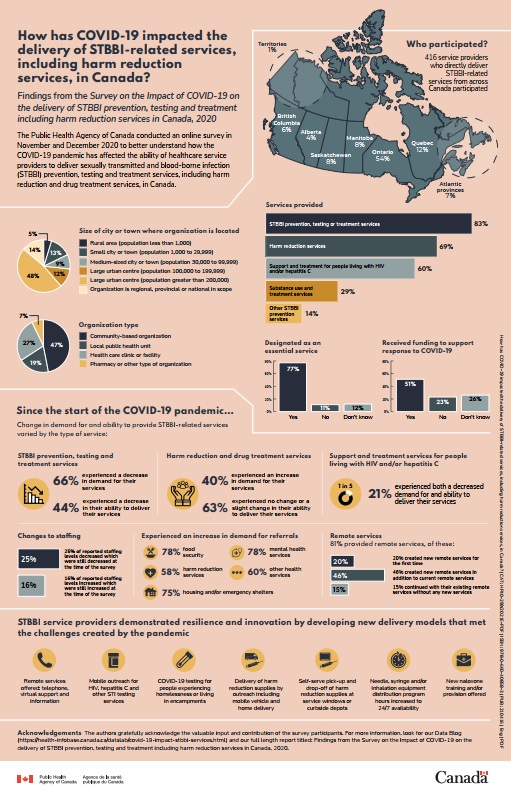Impact of COVID-19 on the delivery of STBBI-related services in Canada, including harm reduction services

Download the alternative format
(1.09 MB, 1 page)
Organization: Public Health Agency of Canada
Date published: 2022-03-03
Cat.: HP40-299/2021E-PDF
ISBN: 978-0-660-40858-3
Pub.: 210416
Findings from the Survey on the impact of COVID-19 on the delivery of transmitted and blood-borne infection (STBBI) prevention, testing and treatment in Canada, including harm reduction services, 2020.
The Public Health Agency of Canada conducted an online survey in November and December 2020 to better understand how the COVID-19 pandemic has affected the ability of healthcare service providers to deliver STBBI prevention, testing and treatment services, including harm reduction and drug treatment services, in Canada.
Who participated
- 416 service providers who directly deliver STBBI-related services from across Canada participated
- Territories: 1%
- British Columbia: 6%
- Alberta: 4%
- Saskatchewan:8%
- Manitoba: 8%
- Ontario: 54%
- Quebec: 12%
- Atlantic: 7%
Size of city or town where organization is located
- Rural area (population less than 1,000): 5%
- Small city or town (population between 1,000 to 29,999): 13%
- Medium-sized city or town (population between 30,000 to 99,999): 9%
- Large urban centre (population between 100,000 to 199,999): 12%
- Large urban centre (population greater than 200,000): 48%
- Organization is regional, provincial or national in scope: 14%
Services provided
- STBBI prevention, testing or treatment services: 83%
- Harm reduction services: 69%
- Support and treatment for people living with HIV and/or hepatitis C: 60%
- Substance use and treatment services: 29%
- Other STBBI prevention services: 14%
Organization type
- Community-based organization: 47%
- Local public health unit: 19%
- Health care clinic or facility: 27%
- Pharmacy or other type of organization: 7%
Designated as an essential service
- Yes: 77%
- No: 11%
- Don't know: 12%
Received funding to support response to COVID-19
- Yes: 51%
- No: 23%
- Don't know: 26%
Since the start of the COVID-19 pandemic
- Change in demand for and ability to provide STBBI-related services varied by the type of service:
- STBBI prevention, testing and treatment services:
- 66% experienced a decrease in demand for their services
- 44% experienced a decrease in their ability to deliver their services
- Harm reduction and drug treatment services:
- 40% experienced an increase in demand for their services
- 63% experienced no change or a slight change in their ability to deliver their services
- Support and treatment services for people living with HIV and/or hepatitis C:
- 21% experienced both a decreased demand for and ability to deliver their services
- Changes to staffing:
- 25% of reported staffing levels decreased which were still decreased at the time of the survey
- 16% of reported staffing levels increased which were still increased at the time of the survey
- Experienced an increase in demand for referrals:
- 78% food security
- 78% mental health services
- 58% harm reduction services
- 60% other health services
- 75% housing and/or emergency shelters
- Remote services: 81% provided remote services, of these:
- 20% created new remote services for the first time
- 46% created new remote services in addition to current remote services
- 15% continued with their existing remote services without any new services
- STBBI prevention, testing and treatment services:
STBBI service providers demonstrated resilience and innovation by developing new delivery models that met the challenges created by the pandemic
- Remote services offered: telephone, virtual support and information
- Mobile outreach for HIV, hepatitis C and other STI testing services
- COVID-19 testing for people experiencing homelessness or living in encampments
- Delivery of harm reduction supplies by outreach including mobile vehicle and home delivery
- Self-serve pick-up and drop-off of harm reduction supplies at service windows or curbside depots
- Needle, syringe and/or inhalation equipment distribution program hours increased to 24/7 availability
- New naloxone training and/or provision offered
Acknowledgements
The authors gratefully acknowledge the valuable input and contribution of the survey participants. For more information, look for our Data Blog and our full-length report titled: Findings from the Survey on the Impact of COVID-19 on the delivery of STBBI prevention, testing and treatment in Canada, including harm reduction services, 2020.